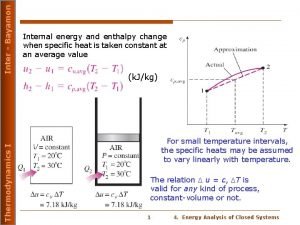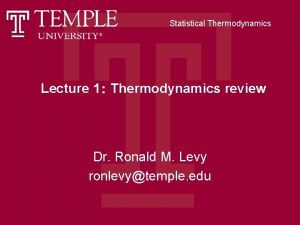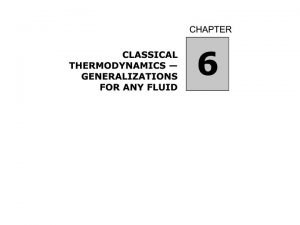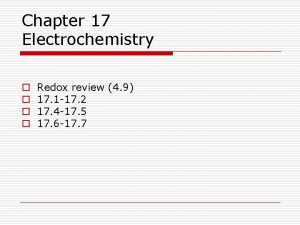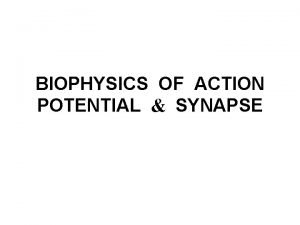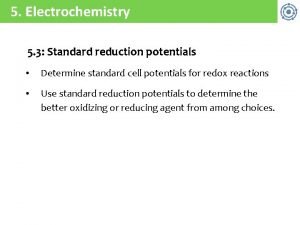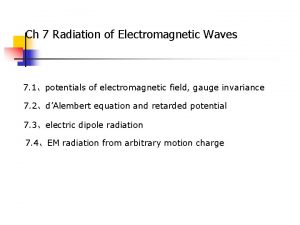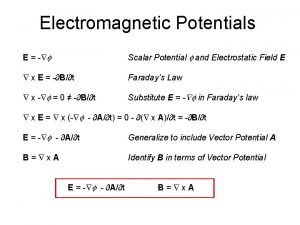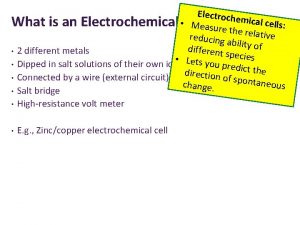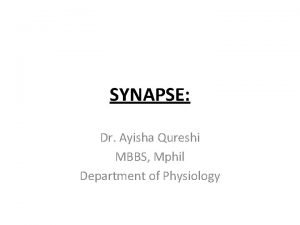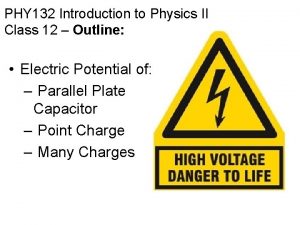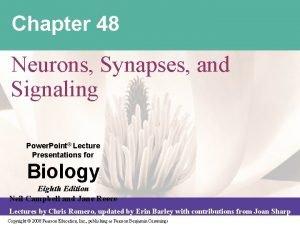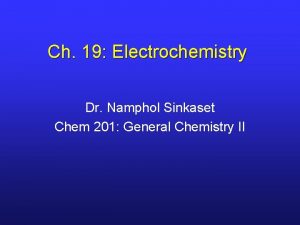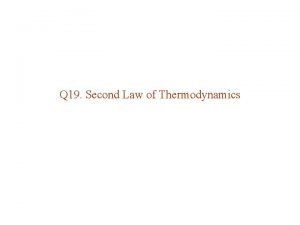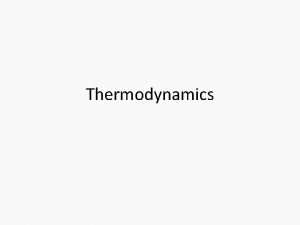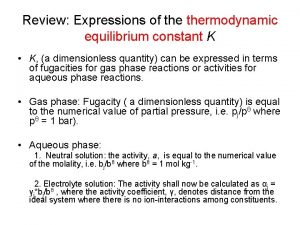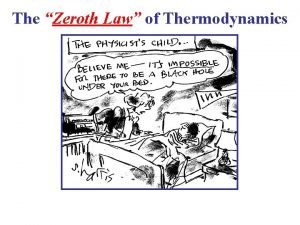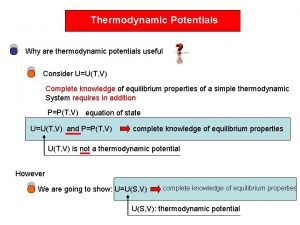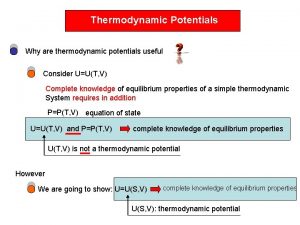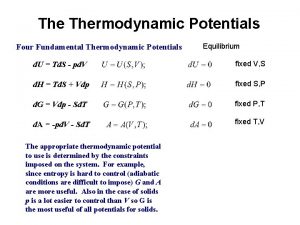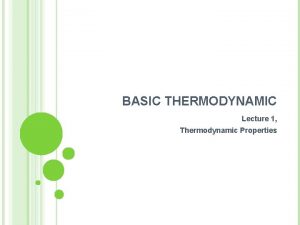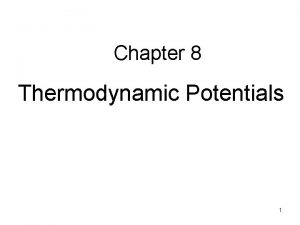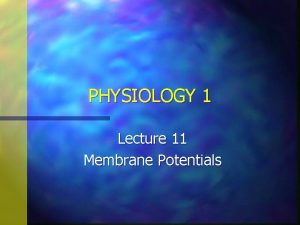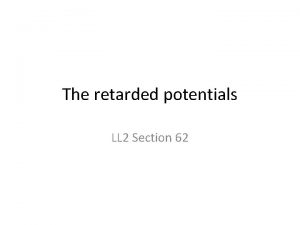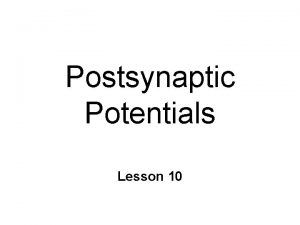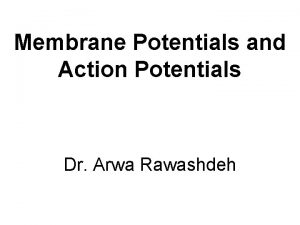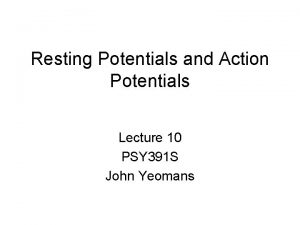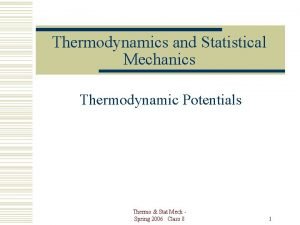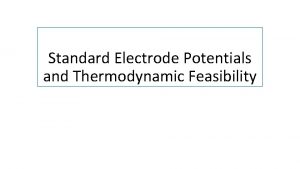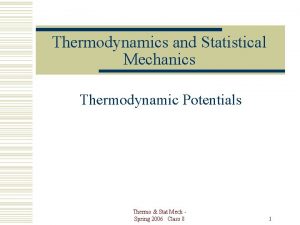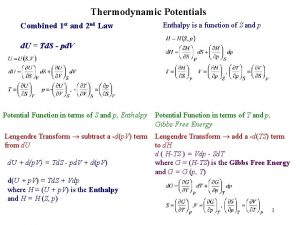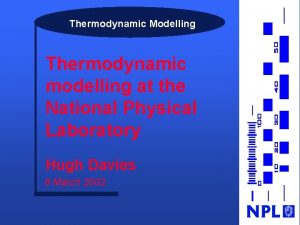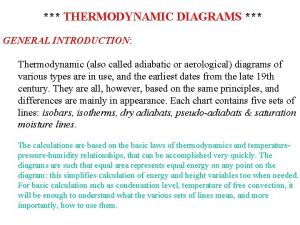Thermodynamic potentials Now we shall discuss various thermodynamic



























- Slides: 27

Thermodynamic potentials Now we shall discuss various thermodynamic potentials more systematically. We start with the first law of thermodynamics written for reversible processes. 1

Thermodynamic potentials 2

Free energy So for isothermal process infinitesimal pieces of work can be easily integrate to get Free energy can be understood as the isothermal potential of work. It says how much mechanical work can be extracted from a device in an isothermal process. This is perhaps the motivation for its name “free energy”. 3

Furthermodynamic potentials So for isobaric processes infinitesimal pieces of performed heat can easily be integrated to get

Furthermodynamic potentials 5

Furthermodynamic potentials 6

Non-equilibrium macrostates - entropy 7

Non-equilibrium macrostates Non equilibrium macrostate of a gas needs more variables for its specification. These additional variables characterize how the non-equilibrium state differs from the equilibrium. Consider gas in an isolated container having two compartments separated by a non-penetrable diaphragm. The temperature is the same in both compartments, but the number of molecules and therefore the pressure might be prepared as different. Free expansion: 8

Non-equilibrium macrostates – thermodynamic potentials All other non-equilibrium thermodynamic potentials are defined by the appropriate Legendre transformations from energy and entropy. Now what about the differentials (potential changes during infinitesimal processes). For reversible (equilibrium) processers we had for example This cannot be a correct expression for the differential of a non-equilibrium entropy, since there are more independent (non-equilibrium) parameters and their differential are missing in the above expression. So the correct formula has to look like this 9

Non-equilibrium macrostates – extremal entropy Therefore we formulate the hypothesis, that for arbitrary infinitesimal processes the following inequality holds The equality holds for equilibrium (reversible) processes. The above inequality express our starting hypothesis that the isolated system increases its entropy during its approach to equilibrium and the entropy of an isolated system is maximal for the 10 equilibrium macrostate.

Non-equilibrium macrostates – Clausius inequality First law of thermodynamics (energy conservation) says So we get for a general (reversible or irreversible) process the Clausius inequality Actually the Clausius inequality can be proven from the second law of thermodynamics, we shall not present the proof here. 11

Thermodynamic potentials – irreversible processes The Clausius inequality for entropy can be rearranged for the inequality for differential of energy for reversible and irreversible processes 12

Finding equilibrium by minimizing the free energy 13

Finding equilibrium by minimizing the free energy 14

Finding equilibrium by minimizing the free energy 15

Finding equilibrium by minimizing the free energy The nonequilibrium free energy will be This is exactly the same as we got using standard “canonical mean” technique. 16

Quantum ideal gas

Quantum ideal gas j 1 2 3 4 5 6 7 8

Fermi gas: Fermi-Dirac distribution

Bose gas: Bose-Einstein distribution This result is, of course, valid only for convergent series, so the following must be true

Bose gas: Bose-Einstein distribution The probabilities of occupational numbers will be The mean value of the occupational number will be We did a clever trick with the derivative after which we got a geometrical series. The rest of the calculation is trivial. Finally we get

Quantum ideal gas – classical limit we shall now investigate the situation, when the mean occupancy of all one-particle states is much less than 1. We expect that then the quantum effects can be neglected and get results as for classical particles with the exception of the Gibbs paradox: indistinguishability is manifested even in the classical limit. So we look for situations where This requirement leads to the same condition for bosons and fermions The sum is over all the (discrete) values of the energies of the one-particle states.

Quantum ideal gas – classical limit

Quantum ideal gas – classical limit We have calculated the chemical potential! Of course, the result is valid only in the classical limit, what requires or

Ideal gas – classical limit – grand partition function We shall demonstrate now the calculation of the grand partition function for an ideal gas in the classical limit. The gas microstate is given by the list of the occupational numbers, which we shall denote as The grand partition function is the sum over all gas microstates (over all possible lists}: Be careful and understand well what the symbols mean! The overall sum is over all possible infinite lists of occupational numbers. The sums in the exponent are over the occupational numbers in one specific list. Now exponent of a sum is a product of exponents: Now the most difficult (for understanding) rearrangement according to the distributive law. Symbolically but imprecisely: “sum of products is the product of sums”.

Ideal gas – classical limit – grand partition function The classical limit also means logarithms so we approximate the We got just the sum over mean occupational numbers, what gives the total number of particles. So in the classical limit

Ideal gas – classical limit – entropy Summarizing the results we have obtained we continue by calculating the entropy of an ideal gas in the classical limit. We start with the relation This formula is called Sackur-Tetrode equation for the entropy of monoatomic classical ideal gas. It demonstrates that the statistical physics is able to calculate the entropy absolutely: there is no arbitrary additive constants, while the phenomenological thermodynamics is able to determine entropy only up to an additive constant.
 Free energy
Free energy Explain helmholtz electrical double layer
Explain helmholtz electrical double layer Maxwell thermodynamic relations
Maxwell thermodynamic relations Gibbs free energy
Gibbs free energy Explain briefly the 7 steps of portfolio process
Explain briefly the 7 steps of portfolio process Example of dimension in research
Example of dimension in research Hyperbole in romeo and juliet
Hyperbole in romeo and juliet Amateurs discuss tactics professionals discuss logistics
Amateurs discuss tactics professionals discuss logistics Standard reduction potential table
Standard reduction potential table What are electrical synapses
What are electrical synapses Graded potentials
Graded potentials Cathode anode standard reduction potential
Cathode anode standard reduction potential Lienard-wiechert potentials
Lienard-wiechert potentials What is scalar potential
What is scalar potential Graded vs action potential
Graded vs action potential Task 8 electrode potentials answers
Task 8 electrode potentials answers Epsp vs ipsp
Epsp vs ipsp Two protons one after the other are launched
Two protons one after the other are launched Postsynaptic potentials
Postsynaptic potentials Use the tabulated half-cell potentials to calculate
Use the tabulated half-cell potentials to calculate Sources of biopotential
Sources of biopotential Now i see it now you don't
Now i see it now you don't Second law of thermodynamic
Second law of thermodynamic Organic chemistry 2nd edition klein
Organic chemistry 2nd edition klein Thermodynamic intensive properties
Thermodynamic intensive properties Thermodynamic equilibrium constant
Thermodynamic equilibrium constant Thermodynamic
Thermodynamic Zeroth law example
Zeroth law example
